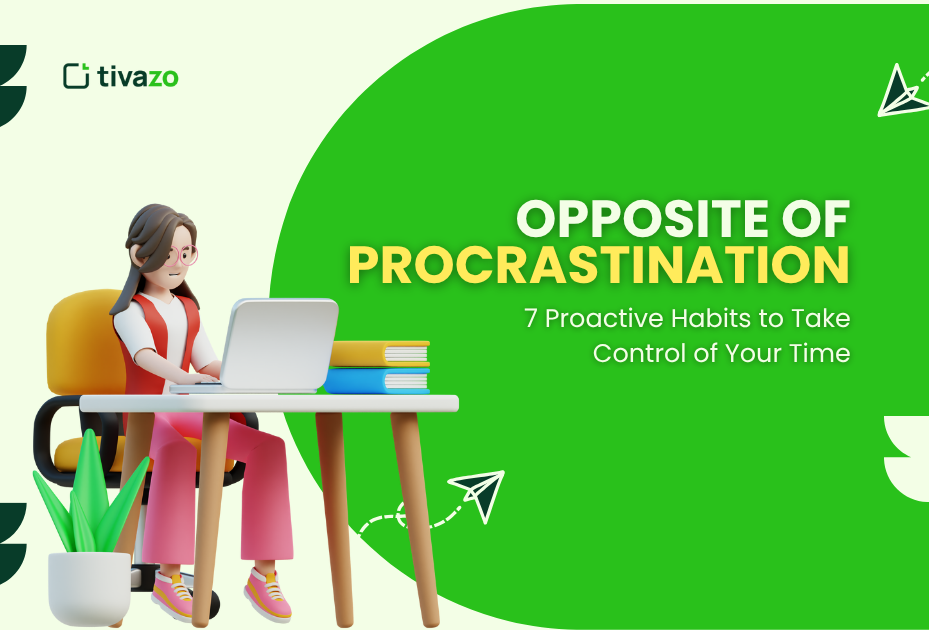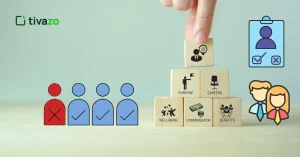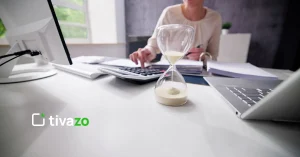We’ve all experienced procrastination — that sinking feeling of passing the time even though we know we’ve got stuff to do. But what is the opposite of procrastination? Is it working nonstop? Is it perfectionism? Or is it something deeper?
In this guide, we’ll explore the reasons why we procrastinate and share 7 proactive habits to help you reclaim control of your time, energy, and life, which will make you understand the opposite of procrastination.
Foundation is, of course, where it all starts.
Key Points
- Procrastination vs. Laziness: Are They the Same
- 5 Common Types of Procrastinators
- 7 Proactive Habits to Beat Procrastination
- Techniques to Overcome Procrastination
- The Neuroscience of Taking Action
- Benefits of Becoming a Proactive Person
What Is the Opposite of Procrastination?
The actual opposite of procrastination isn’t just “doing things early.”
It’s proactive behavior — the intentional practice of acting in advance of a future situation, rather than just reacting to the circumstances. Whereas procrastination is based on avoidance and delay, proactivity is based on ownership, clarity, and momentum.
Some psychologists also refer to precrastination, or doing things too early and sometimes at the expense of quality or strategy. But as we will see later, pre-crastination isn’t necessarily the solution either.
Real productivity takes place at the point of intersection between action and alignment — doing the right things at the right time, for the right reasons.
Procrastination vs. Laziness: Are They the Same?
Procrastination and laziness are very different. Laziness is just being against doing things, a lack of motivation. Procrastination, meanwhile, occurs when you wish to act but put it off because of fear, overwhelm, or perfectionism. Procrastinators care and feel guilty, but are trapped, while lazy people don’t feel that struggle.
Understanding this distinction is very important if you want to embody the opposite of procrastination and build constant discipline.
Synonyms for Procrastination & Pre-crastination
Language provides another example of a full appreciation of the nuance.
Procrastination synonyms:
- Delaying
- Avoiding
- Postponing
- Hesitating
- Deferring
Pre-crastination synonyms:
- Rushing
- Over-preparing
- Compulsive completion
- Premature action
Awareness of these can teach us to recognize our inclinations — and change them.
5 Common Types of Procrastinators
But not all procrastinators are created equal. Here are five of the main types, according to research on productivity:

1. The Perfectionist
Perfectionists have a hard time getting started because they’ve convinced themselves that their work won’t be perfect, and that would be terrible. They can get bogged down endlessly planning or editing. To combat this, they must work on progress over perfection and include baby steps in completing tasks.
2. The Dreamer
Dreamers are big fans of big ideas but not of the boring implementation details required to make the magical idea a reality. They are easily being demotivated without a routine. Routines and accountability allow them to move from ideas to action.
3. The Crisis-Maker
In typical crises, crisis-makers are hoping for the last-minute pressure to make things happen, with the aid of adrenaline. This leads to stress and burnout. Earlier deadlines and even work habits, can help break this cycle.
4. The Avoider
Avoiders procrastinate not because they lack self-control, but rather because they feel overwhelmed or fear failure. They must learn to be kind to themselves, and take tasks in little pieces and build up their confidence over time.
5. The Busy Bee
Busy bees are busy doing low-priority tasks to avoid high-priority tasks. To them is being productive is. They decide what to do and spend time working intentionally on focused efforts. This allows them to accomplish meaningful work. Whether you’re a Dreamer or a Crisis-Maker, knowing your type is the first step to nurturing the opposite of procrastination through mindfulness and habit change.
7 Proactive Habits to Beat Procrastination
Here’s how the highly productive, proactive people do it:
1. Set Clear, Achievable Goals
Applying the SMART guidelines — Specific, Measurable, Achievable, Relevant, Time-bound — helps prevent fuzzy goals from causing hesitation. Clear purposes provide your mind with a specific target and eliminate the confusion.
2. Break Tasks into Micro-Steps
Uncertainty is not liked by your brain. Try not to make it one BIG task, but 3-5 small ones so it doesn’t look as bad and can be started more easily. It lessens resistance and propels you forward.
3. Use the 2-Minute Rule
If something takes less than two minutes, do it now. Taking care of little errands immediately helps to eliminate the build-up, and the associated guilt and stress. This is a 2-minute rule.
4. Schedule Daily MITs (Most Important Tasks)
Every morning, choose 1 to 3 essential tasks that correspond to your objectives. Schedule these out during your most focused times of day so that your energy is spent on what matters most.
5. Practice Reflection & Self-Review
Every evening, spend 5 minutes journaling about or reflecting on what you accomplished, what got delayed and what you can do better next time. This is how awareness is created and growth is sustained.
6. Prepare the Night Before
There can be a lot of friction in the morning, so prepare the night before by having tools, clothes, and your workspace ready. This makes for a gentle wake-up and makes your mornings into productivity launch pads rather than holding zones.
7. Take Imperfect Action Daily
Concentrate on progress, not perfection. Just doing something imperfect, even if it’s not much, every day helps to gain momentum, raises your confidence, and gets you past the fear of failure.
These habits are one of the most powerful ways to practice the opposite of procrastination in your life.
Techniques to Overcome Procrastination
Here are a few of the time-honored methods from entrepreneurs, writers, and CEOs:

Pomodoro Technique
In the Pomodoro method, work hard for 25 minutes, then take a 5-minute break. This practice teaches the mind to concentrate in short spurts, developing stamina and staving off burnout.
Time-Blocking
Dedicate blocks of time throughout your day for different activities. This provides organization, that reduces distractions, and therefore it’s easier to stay on the path. This is a time-blocking technique.
Eisenhower Matrix
While doing the Eisenhower Matrix, prioritize based on urgent and Important. This allows you to prioritize what’s most important, not simply what feels most urgent.
Eat That Frog
Get a difficult or unpleasant project done early in the day. Completing this first and having the feedback drives progress and limits later procrastination. This is Eat that Frog technique
How Stress and Fear Fuel Procrastination
But procrastination is not simply a matter of poor time management; it is highly responsive to emotions, especially negative and punitive ones. When you start worrying about failing, or being judged, or just getting overwhelmed, your brain seeks the escape route. Activities such as mindfulness or journaling may also assist in processing these feelings. The trick is to own up that you are afraid, to soothe yourself, and to choose not to yield to it, though it may be unpleasant. To practice the opposite of procrastination is to manage feelings like fear and stress, not just the tasks on your list.
The Neuroscience of Taking Action
Motivation, as it turns out, frequently follows a move, instead of causing it. Your brain’s prefrontal cortex, which manages planning and decision-making, enables you to set goals and make choices. “But when you get stressed or anxious, your limbic system — the emotional center in the brain — can prevail, which leads to feel-and-flee responses.”
The silver lining: Each micro-task you accomplish prompts a dopamine hit, a neurotransmitter associated with both reward and motivation. This shot of dopamine makes your brain want to continue acting, and a feedback loop is created. For this reason, beginning with tiny behaviors (think: 2-minute micro-actions) is so effective — it builds trust between your brain and yourself. When you do this repeatedly, your brain will learn that taking action results in rewards and it will be easier for you to beat procrastination and get things done.
Why We Procrastinate Even When We Know Better
Knowing isn’t doing. There really is a gap between intention and action.
You may wish to write the article, hit the gym, seek that job. But inside friction (doubt, fear, exhaustion) is blocking you.
The solution? Architect your environment to make doing actions easier:
- HIDE YOUR PHONE AWAY
- Use a visual tracker
- Join an accountability group
Reduce friction. Increase momentum. Tools and techniques are great, but one of the quickest ways to activate the opposite of procrastination is by designing your environment.
Creating a Sustainable Mindset: The Real Opposite of Procrastination
The true opposite of procrastination is not diligence or perfect adherence to a task schedule, but sustainable productivity. It’s not about plummeting the number on the scale so much as setting real and doable goals that motivate, not discourage. Stewarding your energy well, by, say, working during your peak focus times and taking appropriate breaks, prevents burnout and promotes consistency. To put it briefly, being truly proactive involves establishing steady, organized work habits that you can sustain over the long haul, and from which you will make substantive progress without becoming frantic or depleted.
Benefits of Becoming a Proactive Person
Proactivity is not just about early — it’s also self-empowering.
Here’s what changes when you become proactive:
- You stop feeling and you start creating
- Your confidence comes from doing
- You control your destiny.
- You build self-trust and emotional strength
In short? You are living your life not letting it live you.
Difference between Procrastination and Precrastination

Daily Rituals That Replace Procrastination with Purpose
Our daily habits have a lot to do with the kind of people we eventually become. By embracing a few powerful daily rituals, you can replace procrastination with purposeful action to create durable change.
Morning Clarity Ritual: Start your day by intentionally visiting your 3 core goals. This sharpens the mind on what’s important and establishes an intent for the day.
Pre-Work Launch Pad: Five minutes focused timer work with deep breaths. It helps you to calm any nerves, center yourself, and get your mind ready to be productive.
Evening Reset: End the day by reviewing what went well and what could have been better. 3. Use this window of time to reflect on what needs to happen tomorrow so you can go to sleep with a plan and a bit less brain clutter.
These little, routine rituals might seem minuscule, but they accumulate into enormous changes over time. They help gain momentum, eliminate overwhelm and generate a proactive state of mind that replaces doubt with a clear, strong action.
How the Environment Shapes the Opposite of Procrastination
Your environment is a very important factor in developing your habits. A cluttered space is a noisy space and it only leads to procrastination, where else a clutter free space is encouraging. Doing things as simple as decluttering your workspace, eliminating digital distractions, and incorporating elements that inspire you (plants or vision boards, for example) can make a big difference in your ability to take consistent action. Building an atmosphere conducive to focus is a core segment of becoming the opposite of procrastination.
Conclusion: Make the Opposite of Procrastination Your New Habit
Learning to reverse-engineer in the opposite of procrastination is not just a skill for getting things done — it’s a skill for changing how you think about work and time. You can create lasting change by understanding which type of procrastinator you are and employing strategies that work for you, and by building emotional intelligence.
Start today with one small step and build momentum. Your future self will thank you for choosing proactive, intentional action over delay.
FAQs
What is the antonym for procrastination?
Common antonyms include proactivity, readiness, or promptness—traits that involve initiative and timely decision-making.
What is reverse procrastination?
Reverse procrastination, or precrastination, is the tendency to complete tasks too quickly, often without strategic planning.
What virtue is the opposite of procrastination?
The virtue most aligned with the opposite of procrastination is diligence—steady, focused effort toward meaningful goals.
How can I train myself to act instead of avoid?
Start small. Use tools like the Pomodoro Technique, habit stacking, and daily MITs (Most Important Tasks) to build momentum and consistency.




